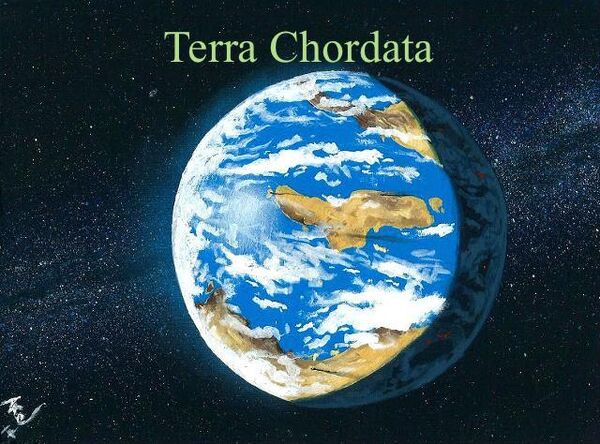(download)
- Note: this is a team project. That means that although it is not private, you must be accepted into the team in order to contribute. Currently, the team consists of Marcello27 and Myotragus.
| Terra Chordata | |
|---|---|
| Astronomy and Geology | |
| Auster • History of Auster | |
| Life Forms | |
| Benthochordata • Thalassaflora | |
This is a terraformed planet with a difference. Instead of a high invertebrate diversity and a low chordate diversity, it is the other way around. There were six chordates and only one invertebrate introduced. The lifeforms introduced are listed below:
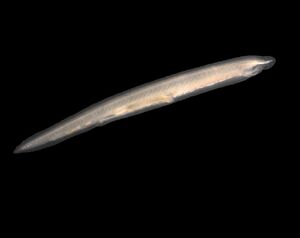
Branchiostoma lanceolatum, one of the lancelets introduced
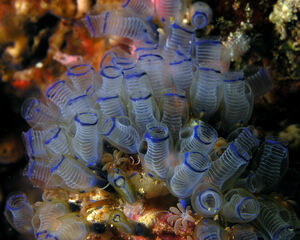
Clavelina moluccensis, a sea squirt; one of the tunicates introduced
- Various bacteria and archaea
- Diatoms
- Cyanobacteria
- Green algae
- Various microbial algae
- Echiniscoides sigismundi (tardigrade)
- Branchiostoma lanceolatum (lancelet)
- Branchiostoma floridae (lancelet)
- Epigonichthys hectori (lancelet)
- Epigonicthys australis (lancelet)
- Clavelina moluccensis (tunicate)
- Oikopleura dioica (tunicate)
Overview[]
Epsilon Eridani System[]
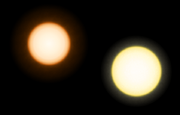
Comparison of Epsilon Eridani (left) and the sun (right)
Auster, officially Epsilon Eridani e, named after the Roman god of the south wind, is a super-Earth, about 1.5 times the diameter of Earth. The gravity is about 1.6 Earth's gravity. Auster lies about 97 million km (60 million miles) away from its star, Epsilon Eridani, which is a K2 class star and lies 10.5 light years from Earth. Auster's orbital period is 302 days. The stellar system contains four planets, with one closer to Epsilon Eridani than Auster and two gas giants farther away from the orange dwarf.
Epsilon Eridani c[]
The innermost planet, Epsilon Eridani c, is 48 million km (30 million miles) from the star, and is about the size of Mars. Its temperature averages 350°C, so it is hostile to life. It orbits in 101 days and lacks an atmosphere. Its composition is mostly silicon and iron. Epsilon Eridani c lacks any satellites.
Epsilon Eridani b[]
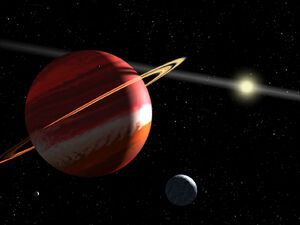
An artist impression of Epsilon Eridani b
Epsilon Eridani b, the third planet from Epsilon Eridani, is 468 million km (302 million miles) from Epsilon Eridani and is larger than Jupiter, at around 1.5 Jovian masses. It orbits its star in about seven years, and its coloration is crimson. The planet has three large satellites, and many smaller ones. It is composed of mostly hydrogen and helium.
Epsilon Eridani d[]
Epsilon Eridani d, the outer gas giant in the system and fourth planet from Epsilon Eridani, is over 4.8 billion km (3 billion miles) from its star, and is a small gas giant, slightly larger than Neptune. It orbits its star in approximately 270 years. Like Neptune, it is home to very fast winds and has a similar place in the stellar system. Its coloration is bluish-green. Although mostly hydrogen and helium, methane is also present in the atmosphere. Epsilon Eridani d has one large satellite, and about ten smaller ones.
Auster[]
- Main article: Auster (Terra Chordata)
Auster's environment is quite similar to that of Earth. The climate is very tropical due to a high carbon dioxide level, with a worldwide temperature similar to the Amazon Rainforest. The ocean makes up about 80% of Auster's surface area, and thus it has more aquatic diversity than Earth. Almost no ice exists on Auster. The depth of the ocean reaches 50,000 feet, so overall Auster has much more water by volume than Earth. Still, no life existed on Auster until the planet was terraformed, despite all of the Earth-like conditions.
Three continents exist, one stretching across most of the southern hemisphere, going over the south pole; and two smaller continents in the northern hemisphere. Even the tallest mountains rarely reach above 10,000 feet above sea level, and most land is swampy and low lying. Auster is far more tectonically active than Earth. The oxygen concentration is about 15% in the atmosphere, and nitrogen makes up 83%. 1.5% is carbon dioxide, and the rest is composed of trace elements.
Auster can be broken up into similar compositional and physical layers to Earth, but due to pressure it lacks a fully liquid outer core, with a similar density to the its mantle. For this reason, its magnetic field is weaker, and animals have had to adapt to the slightly harsher radiation. Auster has one satellite, a 32 kilometer (20 mile) wide asteroid, caught in orbit 200 million years before Auster was terraformed. The satellite is named Aethiopius, after the land (Aethiopia) where Auster lived in Greco-Roman mythology.
History of Auster[]
- Main article: History of Auster (Terra Chordata)
Auster is 1.5 times Earth's diameter, and thus large enough to have different tectonic and ecological activities occur. Many of these activities simply occur sped up compared to Earth, such as supercontinent cycles and recovery from an extinction. During Auster's history, four mass extinctions have occurred, with the largest being caused by a combination of volcanic activity in the Nyx Traps and three asteroid impacts.
Interestingly, Auster has had several different dominant fauna, affecting each group in predictable ways. During the first 60 million years, tardigrades were dominant, until a mass extinction which wiped them out on the planet. During the next era, all major groups were primarily basal sub-clades of modern major groups, which later went extinct. Often, one group would take the niche another would hold in the future. By the third era, all tunicate groups had their present niches, but certain groups, most noticeably the modern Thalassaflora, were still diversifying. Meanwhile, lancelets were still grasping onto new niches. During the last two eras (which were only separated by a relatively minor extinction) the colonization of the land was a major event, with nearly all modern terrestrial groups colonizing the land after the eruption of the Nyx Traps.
Life Forms[]
The life forms here are members of an adaptive radiation, with only seven animals being introduced; they evolved into hundreds of thousands of species. The project is set 400 million years after landing. It may seem like a big task, but with this amount of time extreme biodiversity is inevitable. The following are the many life forms which evolved from the introduced animals on the planet.
Cyanobacteria Descendants[]
Giant, land dwelling cyanobacteria fill the niche of true plants on Auster, as the algae never took the niche, instead dominating the water.
Green Algae Descendants[]
Unlike Earth, the algae are a solely aqautic group, but they fill almost every aquatic plant niche in the Austerian oceans, considering the lack of plants on Auster.
Pseudophycos "Seaweed-Like"[]
The name of these algae is a great description of the group. Many members downright look like seeweed, sprouting from the sand of the ocean bottom. In inner anatomy these groups also resemble seaweeds like kelp. However, other members of this very diverse group are free floating, or lie completely in the sand. Some derived groups have evolved a lack of the need of sunlight, as they grow to the bottom of Auster's seas, being some of the planet's very diverse extremophile assemblages.
Caerulaephyta "Blue Plants"[]
Despite the name, they are not plant equivelents. However, they do use photosynthesis. They live in shallow water, rarely more then 30m deep. ~70% of their members are characterised by their blue color, derived from a gene used to deal with higher radiation levels, and gives the group its name. This is one indication that their photosynthesis is different from that of plants, not using chlorophyll to get energy from their star, Epsilon Eridani.
Lancelet Descendants[]
Xenopisces "Alien Fish"[]
Descendants of lancelets, Xenopiscids are a very diverse group of fish-like creatures. They have a cartilaginous structure that is vaguely similar to a spine, as well as a true brain. They don't however have eyes, relying instead on an electrolocative sensory system like those of sharks and rays. They are one of the groups filling fish niches, along with the Hexapterygii.
Cystonychae "Clawed Sac"[]
A group of aquatic lancelet descendents; they might vaguely resemble arthropods from a distant onlooker, but are up close are something very different. One important difference from arthropods is the lack of an exoskeleton, with a more chordate-like skin, being chordates. They have a large, usually bloated body, and multiple claws surrounding the mouth, most species featuring four claws (Not for similarity among clades, but for the dominance of one clade over the others.). Their body has two semi-large air-sacs, which are inflated or deflated in order to control vertical movement, as they have no good way of propelling themselves, except one group that uses a water jet-like organ to push themselves along. Diet varies wildly among the group, thought they rarely reach over a meter. These sacs are also connected to the respiratory system, which is very efficient and unlike those of any earth life.
Xenopaleae "Prehistoric Aliens"[]
Sister group to the Cystonychae, they are largely terrestrial, and look quite similar to arthropods. They do however lack a true exoskeleton, instead having layered patches of cartilage and thick, leathery skin. They also differ from insects in their efficient, sack based lungs, which are shared with the Cystonychans. Because of these, they can reach much larger sizes then the arthropods, and get their name from the Giant Prehistoric insects of earth, which they recall.
Hexapterygii "Six Fins"[]
A group of fish-like lancelet descendants, the Hexapterygii have retained the basic long, thin lancelet body shape. They have six lobe fins, with two pairs in the front and one pair in the back. They have semi-transparent skin; all species have eyes and a brain. Most species are predators, but secondarily herbivorous forms have evolved. Some species are also amphibious; they have lungs, but with a different structure than those of most Sarcopterygii and Tetrapoda. The Hexapterygii are not very diverse, but are quite successful, taking the niche of many Earthly bony fish.
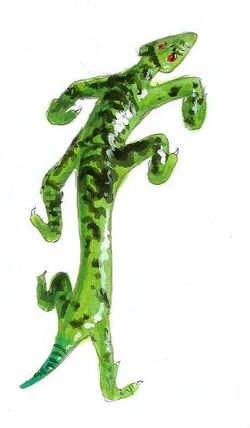
A generic exapod bodyplan
Along their line of evolution, the Hexapterygii gave rise to a strange terrestrial group, the Exapoda. All species have six limbs. Exapods lack a larval stage, and have a very unusual reproductive strategy, a variant of amniotic eggs. Their eggs are made of a water-tight stretched membrane, essentially a skin-shelled egg. Inside is a sort of yolk sac, similar to reptiles and birds. Their diversity, over 10,000 species, has created a number of unique forms. Some species are burrowers, some are lizard-like, and one small group has taken to the skies. This aerial group is a compromise between insect-like wings and having legs as part of the wings. The digits are not quite what one would expect, due to the hexapterygians' fin structure. Each of the six fins contains only two "bones", which are really a cartilage-like structure, the material that makes up the skeleton of all hexapterygians. Because of this, only two digits exist on each of the six limbs. Several groups, like the aerial species, have fused their two front limbs with a membrane of skin, making for four digits on each of the front limbs. This is unusual, however, and most species are lizard-like creatures with six legs.
Tunicate Descendants[]
The tunicates have diversified into a variety of niches and groups, but overall keep the illusion of a primitive organism, with jellyfish-, sea cucumber-, and coral-like forms having evolved. However, the complex internal systems of some groups like the rhomaleodermans prove this is incorrect.
Sinexena "Not Alien"[]
These stay essentially unchanged from modern ascidians, but they are almost as diverse as all the earthly forms combined, and hold all of the modern ascidian niches at this stage in the planet's history. In the Tunicate Revolution, between the first and second mass extinctions, there were many groups with the niche, but after the second these took power, replacing all the other groups. This is part of the reason the tunicate revolution is considered to have so much more diversity, as many groups were around filling the same niche, and none were yet ovethrowing each other; with the competition replaced, the diversity of Tunicates in general actually went down, The last of the competition was wiped-out in the Nyx-Trap(s) event.
Rhomaleoderma "Tough Skin"[]
These floating organisms are nothing like any earthly chordate, characterised by their rock-like, hard skin. This impenetrable skin is used to absord the water and oxygen needs of the creatures. They are predators of small prey, which they filter out using their almost unnoticalble mouths. They are very advanced on the inside however. They have no means of self-propultion. Filling the filter feader niche out in the deeper parts of the ocean, they flourish where sessile ascideaceans are not present, and are somewhat competition for basal thalassaflorans.
Thalassaflora "Open-Sea Flowers"[]
- Main article: Thalassaflora (Terra Chordata)
A group of ascidians, the Thalassaflora live in open water and are vaguely similar to jellyfish. Many basal taxa are quite similar to modern sea squirts in anatomy, aside from movement of the body in order to swim. Other groups however are freshwater, have re-evolved a sessile lifestyle, are microscopic, or are macrocarnivores. They are amazingly diverse, with over 200,000 species.
The Dorsaflora are relict group thalassaflores that were very diverse in the past, but were decimated by one of the planet's four mass extinctions. Today only three small groups remain, all endemic to the Chronos Ocean in what could be called the Arctic Circle. They are characterised by their large sail structures, supported by muscle and cartilage, that catch wind to move the creatures. Because of this, they are always floating on the surface, avoiding competition with any other Austerian lifeforms. The reason for their near-demise was the crash in bacteria biodiversity resulting from volcanic activity of the Nyx traps, so named for the Greek Primordial Goddess of the Night, as the ashes blocked out light from the sky on much of the planet.
Benthochordata "Benthic Chordates"[]
- Main article: Benthochordata (Terra Chordata)
The Benthochordata are a group of tunicates resembling echinoderms. They are quite diverse, containing over 40,000 species. They take forms like sea cucumbers, sea urchins, and tube worms. Many species are radially symmetric. Most are benthic crawlers, but a few groups are sessile. All species possess a similar type of mouth, usually a round opening through which they feed on phytoplankton or zooplankton.
One group of benthochordates are the Helminthochordata, a group of mostly sessile sea squirts, and thus the most basal clade of benthochordates. They lack most modifications, and are quite similar to tubeworms. They feed through openings on their topside, effectively mouths. They may have given rise to the other three groups.
Similar to sea urchins, Spheracizoa are spherical. Often they are strikingly colored, with colors such as violet being prominent in most species. Unlike sea urchins, they lack spines, but quite noticeably there are few predators in the oceans, so defenses are not necessary. They have three mouths, unlike other members of the Benthochordata, through which they consume plankton.
The Decasteria are one of the more derived groups of benthochordates, being laterally flattened, like starfish. They have one mouth, in the center of the top side of their body. Like other members of Benthochordata, they are not very motile, but can move in small increments, unlike the Helminthochordata. They have ten fringes, and look similar to certain squashes, giving them the nickname "sea squash". Unlike starfish, these fringes are not actual arms.
By far the most derived group of benthochordates, the Occulobenthi are very motile, and are not radially symmetric, unlike all other benthohordates. Although similar in shape to sea cucumbers, they possess eyes and a head. The front of the head also includes a mouth. The eyes are somewhat primitive, but Occulobenthi have a huge advantage over other benthochordates. Despite their adaptations, they are no more diverse than any other group of benthochordates.
Distomaflora "Double Mouthed Flowers"[]
The Distomaflores are a group of predatory ascidiacean descendants. Unlike many of the other Austerian tunicates, they are still sessile. However, they have left filter feeding behind in favour of predatory habits. Similar to the thalassaflorans, they've adapted the digestive system. But instead of a single mouth for both uses, both are used like this. They are generally mushroom shaped, and live only in coastal waters for the most part. They are a mostly relict group, restricted to the Chronos Sea.
Tardigrade Descendants[]
The tardigrades went extinct on the planet only 60 million years after introduction, so no tardigrades exist on the planet. However, during this first era they remained somewhat dominant. Although many know that they are closely related to arthropods, and thus would be expected to fill arthropod niches, this was most closely (not the exact niche) filled by a few groups of lancelets. The extinction might seem ironic, considering that tardigrades are extremophiles, but in fact only a single species was introduced, and the direction it was heading in was not at all what you would expect in a tardigrade. They have remained the same since the Cambrian, but quickly underwent an adaptive radiation, and finally were wiped out on Auster during the first mass extinction.

